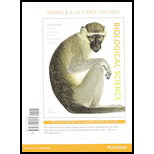
Concept explainers
Introduction:
Phototropism is a mechanism that is mostly seen in the plants. In this mechanism, the plant responds to the light stimulus.
Answer to Problem 1TYK
Correct answer:
Phototropism is the growth of an organism toward a light source (positive phototropism) or away from a light source (negative phototropism). In phototropism, the cells located on the shaded side of a stem elongate more than cells on the illuminated side of a stem.
Explanation of Solution
Explanation/Justification for the correct answer:
Option (c) is given that cells on the shaded side of a stem elongate more than the cells on the illuminated side of a stem during phototropism. The plant tip cells when exposed to light source sense light and release a chemical known as auxin. This results in the process of phototropism. It leads to the elongation of the cells that are far from the light. The shoot bends toward light and cells present in the shaded region of the stem elongate more. Hence, Option (c) is correct.
Explanation for incorrect answers:
Option (a) is given that cells on the illuminated side of a stem elongate more than the cells on the shaded side in phototropism. The cells present on the illuminated side, that is, those cells that are receiving the light, do not extend more. Actually, the cells that are present in the shaded region and are far from the light elongate more than those on the illuminated side due to the chemical auxin released by the cells, which causes phototropism. So, it is a wrong answer.
Option (b) is given that phototropism is triggered by red/far-red light. The bending of the plant occurs only toward the light that includes blue wavelength. Plants have a phototropic response when the blue wavelength is available, which falls in the visible range. Therefore, it is not necessary that phototropism is triggered due to the red or far-red light. So, it is a wrong answer.
Option (d) is given that phototropism is triggered by phytochrome. Phototropism is triggered by a chemical named auxin. This chemical is produced by the cells that are present in the shaded region of the stem, thereby inducing phototropism. So, it is a wrong answer.
Hence, options (a), (b), and (d) are incorrect.
Phototropism refers to the orientation of the plant in response to the light. Cells that are present on the shaded side of the stem extend more than cells that are present on the illuminated side of the stem.
Want to see more full solutions like this?
Chapter 37 Solutions
Biological Science, Books a la Carte Plus Mastering Biology with Pearson eText -- Access Card Package (6th Edition)
- Explain how the hormones of the glands listed below travel around the body to target organs and tissues : Pituitary gland Hypothalamus Thyroid Parathyroid Adrenal Pineal Pancreas(islets of langerhans) Gonads (testes and ovaries) Placentaarrow_forwardWhat are the functions of the hormones produced in the glands listed below: Pituitary gland Hypothalamus Thyroid Parathyroid Adrenal Pineal Pancreas(islets of langerhans) Gonads (testes and ovaries) Placentaarrow_forwardDescribe the hormones produced in the glands listed below: Pituitary gland Hypothalamus Thyroid Parathyroid Adrenal Pineal Pancreas(islets of langerhans) Gonads (testes and ovaries) Placentaarrow_forward
- Please help me calculate drug dosage from the following information: Patient weight: 35 pounds, so 15.9 kilograms (got this by dividing 35 pounds by 2.2 kilograms) Drug dose: 0.05mg/kg Drug concentration: 2mg/mLarrow_forwardA 25-year-old woman presents to the emergency department with a 2-day history of fever, chills, severe headache, and confusion. She recently returned from a trip to sub-Saharan Africa, where she did not take malaria prophylaxis. On examination, she is febrile (39.8°C/103.6°F) and hypotensive. Laboratory studies reveal hemoglobin of 8.0 g/dL, platelet count of 50,000/μL, and evidence of hemoglobinuria. A peripheral blood smear shows ring forms and banana-shaped gametocytes. Which of the following Plasmodium species is most likely responsible for her severe symptoms? A. Plasmodium vivax B. Plasmodium ovale C. Plasmodium malariae D. Plasmodium falciparumarrow_forwardStandard Concentration (caffeine) mg/L Absorbance Reading 10 0.322 20 0.697 40 1.535 60 2.520 80 3.100arrow_forward

 Biology (MindTap Course List)BiologyISBN:9781337392938Author:Eldra Solomon, Charles Martin, Diana W. Martin, Linda R. BergPublisher:Cengage Learning
Biology (MindTap Course List)BiologyISBN:9781337392938Author:Eldra Solomon, Charles Martin, Diana W. Martin, Linda R. BergPublisher:Cengage Learning Biology: The Dynamic Science (MindTap Course List)BiologyISBN:9781305389892Author:Peter J. Russell, Paul E. Hertz, Beverly McMillanPublisher:Cengage Learning
Biology: The Dynamic Science (MindTap Course List)BiologyISBN:9781305389892Author:Peter J. Russell, Paul E. Hertz, Beverly McMillanPublisher:Cengage Learning Concepts of BiologyBiologyISBN:9781938168116Author:Samantha Fowler, Rebecca Roush, James WisePublisher:OpenStax College
Concepts of BiologyBiologyISBN:9781938168116Author:Samantha Fowler, Rebecca Roush, James WisePublisher:OpenStax College Biology Today and Tomorrow without Physiology (Mi...BiologyISBN:9781305117396Author:Cecie Starr, Christine Evers, Lisa StarrPublisher:Cengage Learning
Biology Today and Tomorrow without Physiology (Mi...BiologyISBN:9781305117396Author:Cecie Starr, Christine Evers, Lisa StarrPublisher:Cengage Learning





